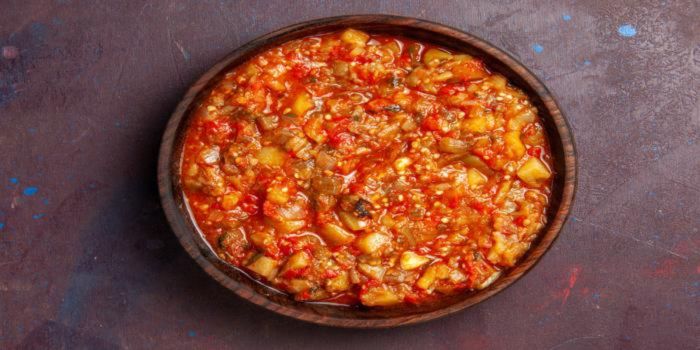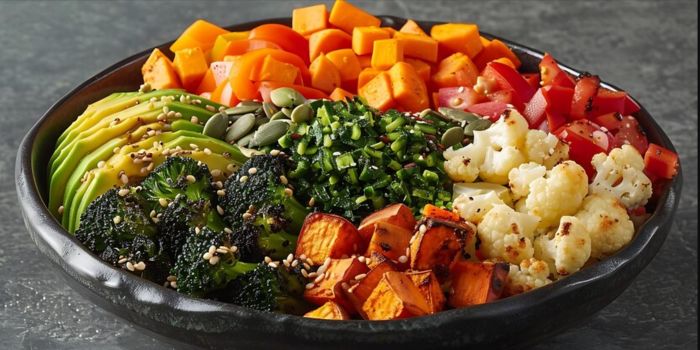Creating the perfect ricotta ravioli filling at home takes only a few minutes, and it’s a recipe that guarantees satisfaction. By mixing creamy ricotta with grated parmesan, salt, pepper, and a splash of lemon juice, you can achieve a vibrant, zingy finish. This versatile filling works wonderfully with various pasta shapes, and with just a spoon, you can dollop the filling onto your dough. It’s the kind of simple perfection that makes you feel like a true Italian cook. Whether you’re making it for a quick family meal or for special occasions, this filling fits the bill.
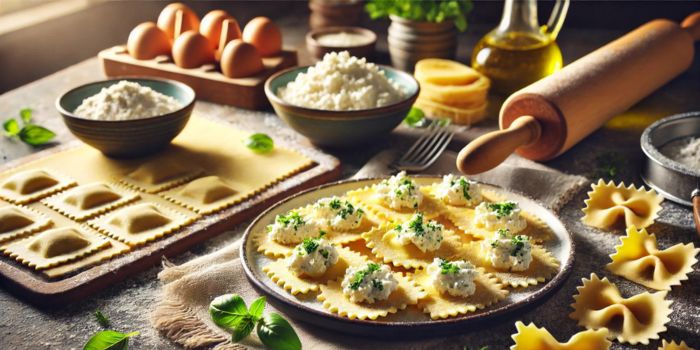
The Ideal Home Pasta Experience
Making pasta at home, especially ravioli, can be a rewarding process. You don’t need a lot of time—just a mixing bowl, some flour, and eggs, and you’re on your way. A pasta machine helps speed up the process, but it’s not essential. Even when shaped by hand, the soft, thin-skinned texture of homemade ravioli is far superior to any store-bought versions, which often have thick, gummy skins. Using fresh ingredients ensures a more flavorful and satisfying result.
Flavors that Make a Difference
What makes this ricotta ravioli filling so special is its ability to add and mix in different flavours. You can stick to the traditional recipe of parmesan and lemon, but feel free to add a pinch of nutmeg or herbs for extra depth. The light, tangy filling pairs exceptionally well with sauces—whether it’s a rich tomato sauce or a more delicate, buttery olive oil blend. It’s important to balance the flavors so that they enhance each other without overpowering the delicate taste of the pasta.
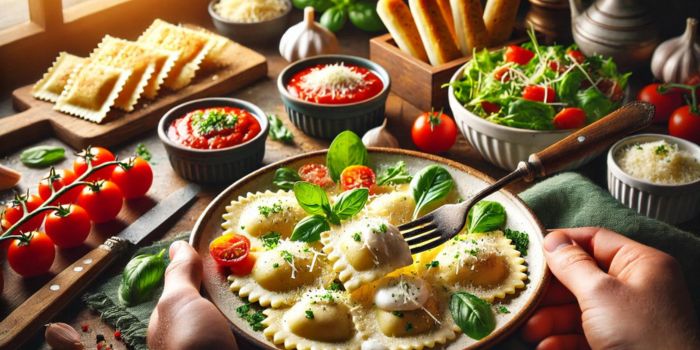
Mastering the Right Balance
A crucial part of making ravioli is ensuring the proper balance between filling and dough. Too much filling, and your pasta might tear; too little, and the flavors won’t shine through. The filling needs to be just right, allowing the dough to stretch tight without breaking. This balance gives you the perfect bite—delicate, flavorful, and filled to perfection. Over time, as you develop your pasta-making skills, you’ll discover your own technique to achieve this harmony.
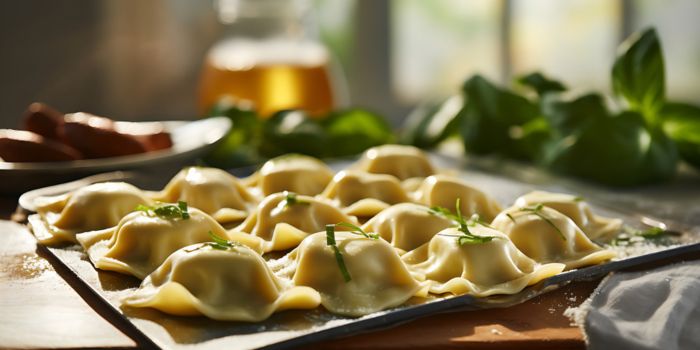
Freezing Homemade Ravioli
One of the advantages of making ravioli at home is the option to freeze it for later. After filling your pasta, you can lay them flat on a tray, freeze them, and then store them for quick meals. This is incredibly convenient for those busy or lazy evenings when you want something delicious but don’t have time to cook from scratch. Just like instant ramen or a prepackaged meal, having frozen ravioli on hand means you’ll always have a ready meal.

And unlike the store-bought version, your homemade ravioli will retain its fresh flavors even after freezing.
Creative Fillings and Personal Touch
The best part about making ravioli is how creative you can get with the fillings. From classic ricotta to more adventurous combinations like spinach and herbs, the possibilities are endless. You can also experiment with different shapes using a ravioli mold or stamp for that professional look. As you continue making ravioli, you’ll refine your technique and gain confidence, allowing you to hone your skills and discover new recipes along the way.

Fresh Ingredients, Real Flavor
What sets homemade ravioli apart from its store-bought counterparts is the quality of the ingredients. Using fresh ricotta, parmesan, and even a touch of olive oil ensures your ravioli will have that rich, complex flavor that’s hard to beat. These fresh ingredients also enhance the delicate texture of the pasta itself, creating a meal that’s far from the drastic difference you’d find between something like instant ramen and a traditional homemade soup. By focusing on fresh, high-quality components, you’re making a dish that’s both delicious and nutritious.
Perfecting the Art of Ravioli
Making ravioli from scratch is not just about following a recipe; it’s about developing a skill. As you practice, you’ll learn to avoid common mistakes, like using watery fillings that can make your dough sticky. Instead, aim for a flavorful filling that’s easy to work with and delicious to eat. It’s a process that takes time, but as you continue to develop your technique, you’ll find that making ravioli becomes second nature.

With each attempt, you’ll get better at finding the right balance between flavors, textures, and ingredients, ensuring a perfect dish every time.
The Importance Of Ricotta Cheese
When making ricotta ravioli filling, the choice of cheese is crucial. Many recipes suggest substituting ricotta with cottage cheese, but this would be a bad decision. The two are completely different types of cheeses, both in how they’re made and in their flavors. Ricotta comes from the whey, while cottage cheese is made from the curds—two separated parts of milk. The process of making ricotta, which means recooked, involves boiling down the whey, giving it a unique texture that’s perfect for ravioli filling.
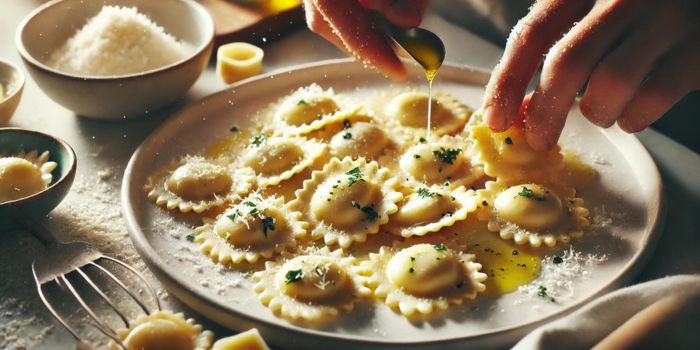
From my personal experience, I learned something interesting about ricotta. During a visit to my local cheese store, the Cheese Monger asked if I wanted cow or sheep’s milk ricotta. I was a bit unprepared, so I hesitated before deciding. I was aiming to pick the more traditional option, but I ended up asking about which was more flavorful. He recommended sheep’s milk for its stronger taste, and though I may have stumbled over my words, his help was greatly welcomed. Sometimes, it’s nice to trust the expertise of those who know their craft well, even if your language skills feel a little weak. The exchange taught me that ricotta can come from different animals, which changes the flavor profile of the dish, and knowing this makes your ravioli even more special.
Why It Works
Draining the ricotta thoroughly keeps the filling firm yet creamy. Adding a little lemon juice balances the flavors with its acidity, complementing the richness and a hint of nutmeg, creating a perfect blend for a delicious bite.

Ingredients
For Filling:
- 500 g Ricotta cheese (ensure it’s well-drained)
- 60 g Parmesan cheese, finely grated
- 2 large eggs
- Zest of 1 lemon
- 1.5 tsp lemon juice
- 1/4 tsp ground black pepper
- 1/8 tsp nutmeg (optional)
- Salt to taste
For Pasta:
- 150 g “00” Flour
- 150 g Semolina (Durum Wheat) Flour
- 3 large eggs
For Cooking and Serving:
- 50 g salted butter
- 8-10 sage leaves
- 70 g grated Parmesan cheese for garnish
Method:
Prepare the Pasta Dough:
- On a clean surface, mix the flour and semolina flour.
- Create a well in the center and add the eggs.
- Using a fork, beat the eggs and gradually mix in the flour.
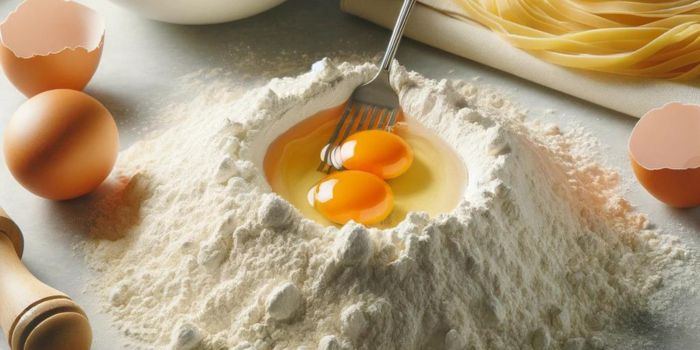
- Once the mixture starts to come together, knead it for about 6 minutes until smooth.
- Wrap the dough in cling film and let it rest in the refrigerator for 30 minutes.
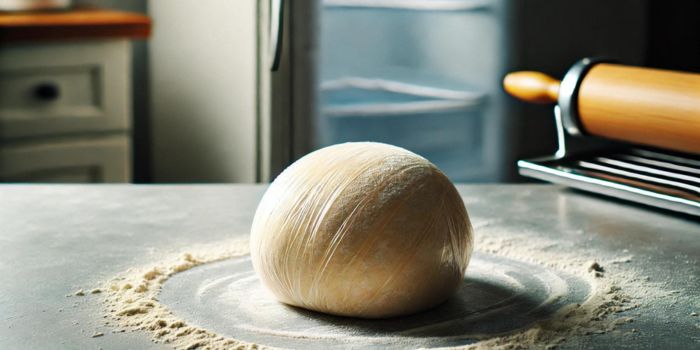
Prepare the Ricotta Filling:
- Drain the ricotta if needed by pressing it between clean towels or using a sieve.
- In a bowl, mix the ricotta, grated Parmesan, lemon zest, lemon juice, black pepper, nutmeg, and a pinch of salt. Stir well until smooth.
- Add the eggs and mix again to ensure the filling is creamy.
- Set aside, or refrigerate if not used immediately.
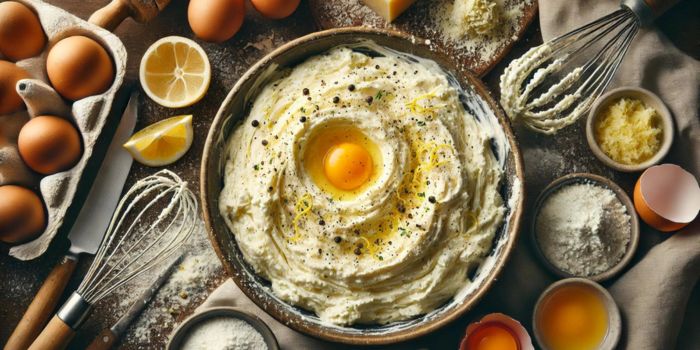
Roll and Shape the Ravioli:
- Divide the rested pasta dough into four equal sections.
- Using a pasta machine or rolling pin, roll each section into thin sheets (approximately 1/16 inch thick).
- Lay one sheet of pasta on a floured surface.
- Add tablespoons of filling, spaced evenly along the lower half of the pasta sheet.
- Lightly brush water around the filling mounds and fold the top half of the pasta over the filling.
- Press around the filling to seal and cut into ravioli squares using a fluted pasta wheel or knife.
- Repeat until all pasta and filling are used. Keep ravioli covered to prevent drying.
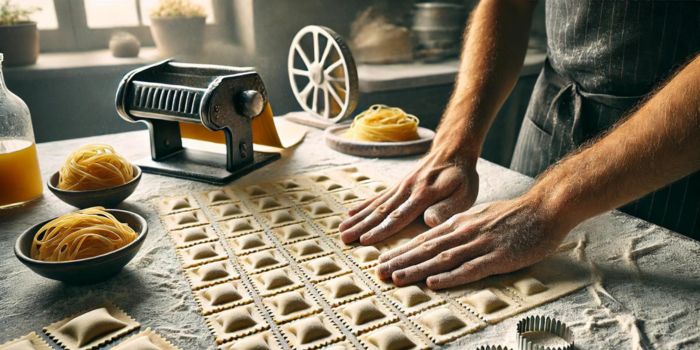
Cooking the Ravioli:
- Bring a large pot of salted water to a boil.
- Cook the ravioli in the boiling water for 3-4 minutes until they float to the top.
- Drain the ravioli and reserve 1/2 cup of the cooking water.
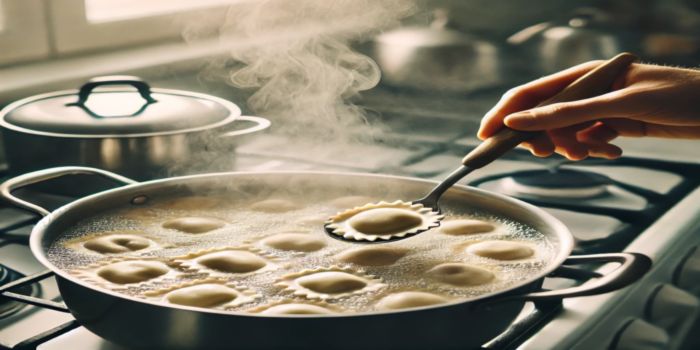
Prepare the Sauce:
- In a skillet, melt the butter over medium heat.
- Add the sage leaves and cook until lightly browned and fragrant.
- Add the cooked ravioli to the butter and sage. Gently toss to coat, adding a splash of the reserved pasta water to create a light sauce if needed.
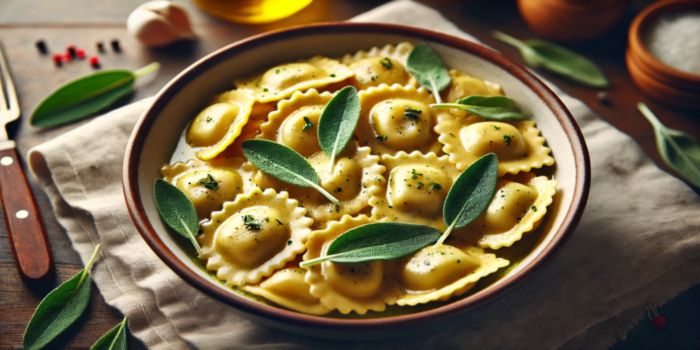
Serve:
- Plate the ravioli and sprinkle generously with grated Parmesan cheese.
- Optionally, drizzle with extra-virgin olive oil before serving.

Additional Info About ricotta ravioli filling
Here is some additional information that you may have to know about ricotta ravioli filling.
Health Benefits:
- Ricotta is rich in calcium, essential for bone health.
- Parmesan provides protein and is a good source of calcium.
- Lemon juice adds vitamin C, boosting immunity.
- Sage has antioxidant and anti-inflammatory properties.

Notes:
- Ensure the ricotta is well-drained for a firm filling.
- Leftover ravioli can be frozen and cooked straight from the freezer.
- The pasta dough should be smooth and elastic after kneading for the best texture.
Nutrition (Per Serving):
- Calories: ~250 kcal
- Protein: 12 g
- Carbohydrates: 20 g
- Fat: 12 g
- Calcium: 200 mg

Equipment:
- Pasta machine or rolling pin
- Mixing bowls
- Skillet
- Fluted pasta cutter or knife
- Pot for boiling water
Serving Suggestions
When it comes to serving ravioli, the real charm lies in choosing the right sauces to enhance the flavor of your dish. A rich brown butter sage sauce can be the perfect way to highlight the creamy ricotta filling, offering a nutty and slightly savory contrast. For a more classic touch, a well-prepared tomato sauce or even a fresh and tangy homemade Sunday tomato sauce can be just as delightful.

These variations allow you to experiment and find the best pairing for your ravioli, whether you want to go traditional or explore a more creative alternative. Regardless of the recipe you follow, the beauty of this dish is in how each sauce transforms the overall experience. Start simple and gradually try different combinations to discover your favorite.
Recipe Tips
When making ricotta ravioli filling, it’s a good idea to prepare the filling a bit ahead of time, so it has a chance to become firmer in the fridge. This helps when you’re working with soft dough, as the filling won’t squeeze through the small gaps in the pasta. A great trick is to use a piping bag to portion out the filling. It might feel like a chef-level move, but trust me, it makes things so much easier than using teaspoons, which can be messy.
It keeps everything clean and easy. You can use a reusable bag or even a snaplock bag with the end cut off, which works just as well. If you’re making ravioli for guests, consider preparing it the day or even a week before, so all you need to do is boil it when the time comes.

Recipe Variation
When making ricotta ravioli, one of the easiest ways to switch things up is by creating a delicious filling with a simple variation. A common addition to the cheese mixture is spinach, which brings a nice texture and flavor. If you’re going this route, I recommend using fresh spinach. To prepare it, just boil the leaves in lightly salted water until they begin to wilt. After that, be sure to drain and thoroughly dry them so they don’t make the filling soggy. Once dry, you can use a blender or food processor to finely chop the spinach. Finally, you’ll want to add it to the ricotta and cheese mixture. This small change can give your ravioli a richer, more savory taste, while keeping the filling light and enjoyable.

Suggestion For Rolling Out The Pasta
When rolling out the pasta for your ricotta ravioli, it’s important to get the thicknesses just right. The dough needs to be thin enough to handle, but not so thin that it tears. Keep in mind, the final layer will be doubled because you’ll have both a top and a bottom layer of the ravioli. If the dough is too thick, the texture can become chewy after cooking, which isn’t ideal. On the other hand, if it’s too thin, the dough may split while cooking, and all your filling could spill out. I’ve found that using the second to thinnest setting on my pasta maker, which is about a 6 out of 7 on the machine, gives a perfect result that holds up well while keeping the pasta light.

What ravioli shapes are best for this filling?
When it comes to ricotta ravioli filling, you really can’t go wrong with this classic recipe. It’s a filling that not only pairs beautifully with any shape of pasta, but it also works well with different styles of ravioli. Personally, I’ve found that triangoli is a fun and simple way to experiment with this filling.
You can easily make this by folding a square piece of dough in half, creating a neat triangle that’s both appealing and easy to handle. This method gives the filling a perfect home, allowing it to stay in place while cooking. Whether you’re trying your hand at something new or sticking to a tried and true shape, this filing is versatile enough to work with almost anything.

What are some other ravioli filling ideas?
One of the best tricks I’ve learned when making ravioli is to always save a bit of whatever delicious meat sauce I have left over. Whether it’s from a rich, flavorful dish like my favorite bolognese or a slow-cooked ragu, you can simply freeze it and use it later as a filling. Even if you’re looking for a vegetarian idea, don’t worry—there are so many great options! For example, you can roast some pumpkin and turn it into a tasty filling similar to agnolotti. But one of the easiest ways is to start with a simple ricotta mixture as your base.
From there, you can get creative and stir in a couple of tablespoons of something like basil pesto or blitzed sun-dried tomatoes. Even adding a tablespoon of your favorite fresh herbs can make the filling extra flavorful. It’s a lovely way to experiment with different ingredients and flavors.

What are Ricotta Ravioli Made of?
Ricotta ravioli filling is simple and quick to make, using creamy ricotta as the base, mixed with parmesan, salt, pepper, and a touch of lemon for a fresh, zingy finish. It’s perfect for any ravioli shape or other filled pasta, and you can even spoon dollops on top for a simple touch of perfection.
What are ravioli traditionally filled with?
Ravioli is often served with broth or sauce and has been a staple in Italian family meals for generations. Common fillings include creamy ricotta cheese, fresh spinach, a sprinkle of nutmeg, and a touch of black pepper. Grated lemon rind adds a zesty balance, making this simple combination satisfying and comforting, just as it’s been made in home kitchens for centuries.
Do I have to drain ricotta for ravioli?
To keep the ricotta ravioli filling smooth and prevent it from getting watery, make sure the ricotta is properly drained. Use a strainer for around 20 minutes or a cheesecloth. While waiting, finely mince the spinach with a knife. Once drained, combine in a bowl with spinach, a pinch of salt, and an egg, then mix until smooth.
Ricotta Ravioli Filling Recipe: The Hidden Italian Secret!
Discover a simple and delicious homemade ricotta ravioli filling recipe! Perfectly creamy and easy to make, elevate your pasta dishes with this classic Italian filling.

Ingredients
Method
-
Prepare the Pasta Dough
On a clean surface, mix the “00” flour and semolina flour. -
Create a well in the center and add the eggs.
-
Using a fork, beat the eggs and gradually mix in the flour.
-
Once the mixture starts to come together, knead it for about 6 minutes until smooth.
-
Wrap the dough in cling film and let it rest in the refrigerator for 30 minutes.
-
Prepare the Ricotta Filling
Drain the ricotta if needed by pressing it between clean towels or using a sieve. -
In a bowl, mix the ricotta, grated Parmesan, lemon zest, lemon juice, black pepper, nutmeg, and a pinch of salt. Stir well until smooth.
-
Add the eggs and mix again to ensure the filling is creamy.
-
Set aside, or refrigerate if not used immediately.
-
Roll and Shape the Ravioli
Divide the rested pasta dough into four equal sections. -
Using a pasta machine or rolling pin, roll each section into thin sheets (approximately 1/16 inch thick).
-
Lay one sheet of pasta on a floured surface.
-
Add tablespoons of filling, spaced evenly along the lower half of the pasta sheet.
-
Lightly brush water around the filling mounds and fold the top half of the pasta over the filling.
-
Press around the filling to seal and cut into ravioli squares using a fluted pasta wheel or knife.
-
Repeat until all pasta and filling are used. Keep ravioli covered to prevent drying.
-
Cooking the Ravioli
Bring a large pot of salted water to a boil. -
Cook the ravioli in the boiling water for 3-4 minutes until they float to the top.
-
Drain the ravioli and reserve 1/2 cup of the cooking water.
-
Prepare the Sauce
In a skillet, melt the butter over medium heat. -
Add the sage leaves and cook until lightly browned and fragrant.
-
Add the cooked ravioli to the butter and sage. Gently toss to coat, adding a splash of the reserved pasta water to create a light sauce if needed.
-
Serve
Plate the ravioli and sprinkle generously with grated Parmesan cheese. -
Optionally, drizzle with extra-virgin olive oil before serving.
Nutrition Facts
Servings 8
- Amount Per Serving
- Calories 250kcal
- % Daily Value *
- Total Fat 12g19%
- Total Carbohydrate 20g7%
- Protein 12g24%
- Calcium 200 mg
* Percent Daily Values are based on a 2,000 calorie diet. Your daily value may be higher or lower depending on your calorie needs.
Note
- Ensure the ricotta is well-drained for a firm filling.
- Leftover ravioli can be frozen and cooked straight from the freezer.
- The pasta dough should be smooth and elastic after kneading for the best texture.




